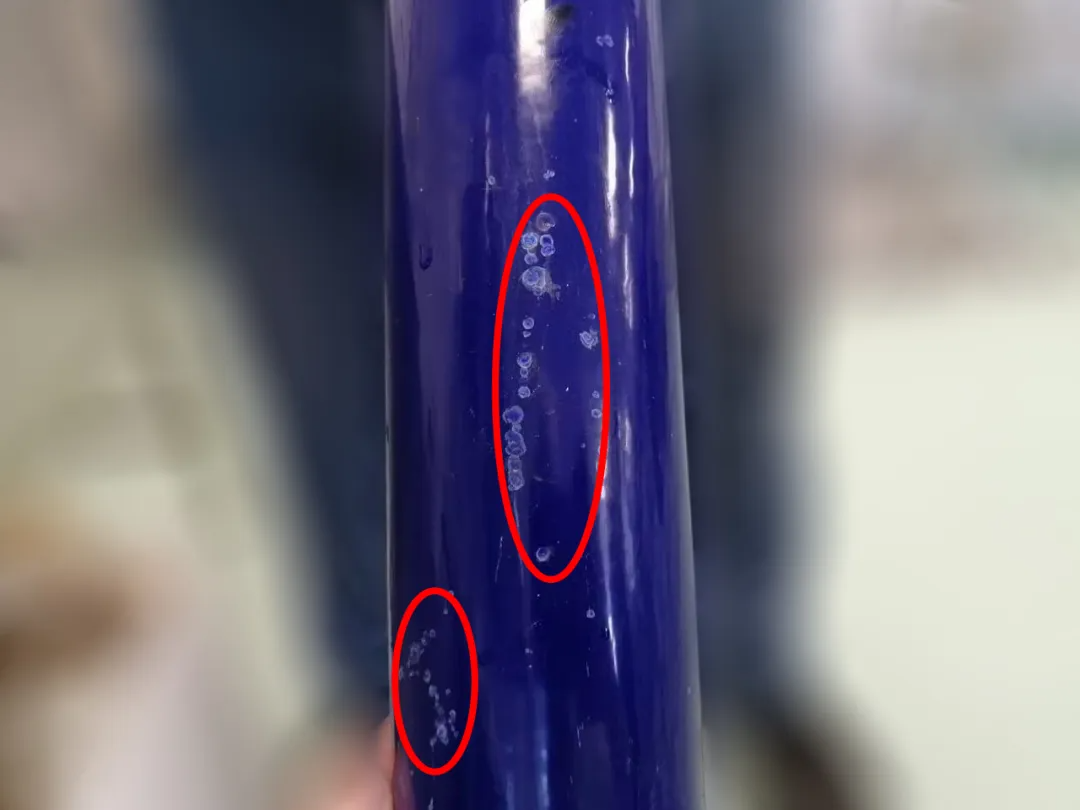Glass-lined equipment use site
Common causes of large-scale porcelain explosion and countermeasures
Glass-lined equipment is one of the common equipment of chemical enterprises. Due to the manufacturing quality of the equipment itself, human factors or other reasons, the product often suffers from porcelain explosion damage. Small-scale porcelain explosion damage may be repaired locally on site, while large-scale porcelain explosion damage has a low chance of on-site repair, and the glass-lined equipment can only be dismantled and sent to the manufacturer for re-lining. The common causes of large-scale porcelain explosion and countermeasures for large-scale porcelain explosion on the use site of glass-lined equipment are introduced as follows.
1. Large-scale porcelain explosion caused by overpressure
1) Large-scale porcelain explosion caused by overpressure of jacket

When chemical enterprises use steam output from power plants for production heating, the steam output from power plants needs to be reduced in pressure before it can be used. Once the pressure reducing valve fails or the safety valve of the steam buffer tank fails, the high-pressure steam output from the power plant is directly input into the jacket of the reactor, causing the jacket to be overpressured, and the reactor wall bulges due to instability of external pressure, causing large-scale porcelain explosion.

Overpressure causes large-scale porcelain explosion Figure 2
Solution: Install a pressure reducing valve on the basis of the existing pressure reducing device, and change the pressure reducing valve from the first stage to the second stage to achieve double insurance. In addition, the working condition of the pressure reducing valve should be checked regularly, and it should be replaced immediately if any problem is found. Some should check whether the steam safety valve is in the correct working state, especially the spring safety valve should be kept in a clean environment, and there should be no corrosion or blocking.
(2) Water freezing in the jacket in winter causes large-scale porcelain explosion
When enterprises in northern regions stop production in winter, the water in the jacket is not drained and is easy to freeze; when water freezes, it changes from liquid to solid, and a phase change occurs. The phase change will produce a physical phenomenon of volume expansion, which makes the jacket and the kettle wall bear huge pressure, causing the external pressure to be unstable and the kettle wall to bulge, resulting in large-scale porcelain explosion. In most parts of the south, the factory buildings are relatively simple and there are no insulation facilities. When there is a strong cold air attack or a sharp drop in temperature, the pipeline is easily blocked by ice, which in turn causes the water in the jacket to freeze and cause the equipment to explode.
Suggestion: In addition to strengthening the insulation of workshops and equipment in the northern region, the water in the circulation system should be completely drained before stopping production. In the southern region, attention should be paid to the insulation of equipment and pipelines, and regular inspections should be carried out to prevent pipeline blockage. At the same time, pay attention to weather changes, suspend production before a sharp drop in temperature, and completely drain the water in equipment, jackets, and pipelines to prevent accidents.
(3) Water in the heat transfer oil causes large-scale porcelain explosion
When using heat transfer oil for heating, the heat transfer oil must be strictly dehydrated before use. When the temperature of the water-containing heat transfer oil exceeds 100℃, the water begins to vaporize. When the heat transfer medium cools, the steam liquefies into water, and so on. The vaporization and liquefaction alternate, that is, vaporization-pressure increase-impact on the kettle wall-liquefaction-pressure reduction-vaporization again... The pressure changes continuously, and the high pressure repeatedly acts on the kettle wall like a hammer. When the pressure reaches a certain value, the kettle wall is deformed. When the oil temperature reaches 230℃, the saturated steam pressure can reach 2.8MPa, which far exceeds the pressure limit of the kettle wall, which will inevitably lead to large-scale porcelain explosion on the inner wall of the equipment.
Solution: First, the heat transfer oil should be strictly dehydrated before use; second, the jacket exhaust hole should be extended with a pipe for emptying. Generally, the jacket shell strength design of heat transfer oil is calculated according to normal pressure, because pressure has no meaning for oil heat transfer. When the heat transfer oil in the jacket is heated, the volume expands, and the expansion rate can generally reach 30%. If there is no facility for the heat transfer oil to flow out freely, the pressure will increase infinitely, causing the kettle to become unstable and deformed. At the same time, the jacket shell will also tear, posing a safety hazard.
(4) Violent reaction of materials causes large-scale porcelain explosion
Some chemical reactions are exothermic reactions. When the reaction temperature exceeds the specified temperature, the materials react violently to produce a large amount of gas, causing the air pressure in the kettle to increase sharply, thereby deforming the inner wall of the glass-lined equipment and causing large-scale porcelain explosion. Another situation is that when two materials come into contact, a large amount of reaction heat is generated. The rapid heat release of the materials causes the porcelain layer to suddenly change due to the temperature difference, causing multiple point-like porcelain explosions.

A large number of point-like porcelain explosions caused by reaction heat
Solution:
① Pay attention to controlling the change of the material reaction temperature during operation to prevent excessive temperature from causing violent reactions.
② Install a pressure relief device to automatically reduce pressure when the pressure in the kettle increases.
(5) Large-scale porcelain explosion caused by thinning of the kettle wall
In order to reduce costs, some glass-lined equipment manufacturers reduce the thickness of the kettle wall, causing the roundness of the high-temperature fired equipment to exceed the standard and the pressure resistance of the equipment to decrease. In addition, the wall thickness of the equipment with a long service life is thinned due to corrosion of the kettle wall by water, oxygen and other media in the jacket, and the pressure resistance of the equipment is reduced accordingly. In the jacket or container, the input of steam at normal working pressure may cause the kettle wall to deform and cause large-scale porcelain explosion.
Recommendation: When ordering equipment, users must emphasize the wall thickness of the equipment, check the ovality of the equipment when receiving the equipment, and regularly inspect the kettle wall of equipment with a long service life during production to prevent large-scale porcelain explosion caused by thinning of the kettle wall.
Common causes of large-scale porcelain explosion and countermeasures
Glass-lined equipment is one of the common equipment of chemical enterprises. Due to the manufacturing quality of the equipment itself, human factors or other reasons, the product often suffers from porcelain explosion damage. Small-scale porcelain explosion damage may be repaired locally on site, while large-scale porcelain explosion damage has a low chance of on-site repair, and the glass-lined equipment can only be dismantled and sent to the manufacturer for re-lining. The common causes of large-scale porcelain explosion and countermeasures for large-scale porcelain explosion on the use site of glass-lined equipment are introduced as follows.
1. Large-scale porcelain explosion caused by overpressure
1) Large-scale porcelain explosion caused by overpressure of jacket

When chemical enterprises use steam output from power plants for production heating, the steam output from power plants needs to be reduced in pressure before it can be used. Once the pressure reducing valve fails or the safety valve of the steam buffer tank fails, the high-pressure steam output from the power plant is directly input into the jacket of the reactor, causing the jacket to be overpressured, and the reactor wall bulges due to instability of external pressure, causing large-scale porcelain explosion.

Overpressure causes large-scale porcelain explosion Figure 2
Solution: Install a pressure reducing valve on the basis of the existing pressure reducing device, and change the pressure reducing valve from the first stage to the second stage to achieve double insurance. In addition, the working condition of the pressure reducing valve should be checked regularly, and it should be replaced immediately if any problem is found. Some should check whether the steam safety valve is in the correct working state, especially the spring safety valve should be kept in a clean environment, and there should be no corrosion or blocking.
(2) Water freezing in the jacket in winter causes large-scale porcelain explosion
When enterprises in northern regions stop production in winter, the water in the jacket is not drained and is easy to freeze; when water freezes, it changes from liquid to solid, and a phase change occurs. The phase change will produce a physical phenomenon of volume expansion, which makes the jacket and the kettle wall bear huge pressure, causing the external pressure to be unstable and the kettle wall to bulge, resulting in large-scale porcelain explosion. In most parts of the south, the factory buildings are relatively simple and there are no insulation facilities. When there is a strong cold air attack or a sharp drop in temperature, the pipeline is easily blocked by ice, which in turn causes the water in the jacket to freeze and cause the equipment to explode.
Suggestion: In addition to strengthening the insulation of workshops and equipment in the northern region, the water in the circulation system should be completely drained before stopping production. In the southern region, attention should be paid to the insulation of equipment and pipelines, and regular inspections should be carried out to prevent pipeline blockage. At the same time, pay attention to weather changes, suspend production before a sharp drop in temperature, and completely drain the water in equipment, jackets, and pipelines to prevent accidents.
(3) Water in the heat transfer oil causes large-scale porcelain explosion
When using heat transfer oil for heating, the heat transfer oil must be strictly dehydrated before use. When the temperature of the water-containing heat transfer oil exceeds 100℃, the water begins to vaporize. When the heat transfer medium cools, the steam liquefies into water, and so on. The vaporization and liquefaction alternate, that is, vaporization-pressure increase-impact on the kettle wall-liquefaction-pressure reduction-vaporization again... The pressure changes continuously, and the high pressure repeatedly acts on the kettle wall like a hammer. When the pressure reaches a certain value, the kettle wall is deformed. When the oil temperature reaches 230℃, the saturated steam pressure can reach 2.8MPa, which far exceeds the pressure limit of the kettle wall, which will inevitably lead to large-scale porcelain explosion on the inner wall of the equipment.
Solution: First, the heat transfer oil should be strictly dehydrated before use; second, the jacket exhaust hole should be extended with a pipe for emptying. Generally, the jacket shell strength design of heat transfer oil is calculated according to normal pressure, because pressure has no meaning for oil heat transfer. When the heat transfer oil in the jacket is heated, the volume expands, and the expansion rate can generally reach 30%. If there is no facility for the heat transfer oil to flow out freely, the pressure will increase infinitely, causing the kettle to become unstable and deformed. At the same time, the jacket shell will also tear, posing a safety hazard.
(4) Violent reaction of materials causes large-scale porcelain explosion
Some chemical reactions are exothermic reactions. When the reaction temperature exceeds the specified temperature, the materials react violently to produce a large amount of gas, causing the air pressure in the kettle to increase sharply, thereby deforming the inner wall of the glass-lined equipment and causing large-scale porcelain explosion. Another situation is that when two materials come into contact, a large amount of reaction heat is generated. The rapid heat release of the materials causes the porcelain layer to suddenly change due to the temperature difference, causing multiple point-like porcelain explosions.

A large number of point-like porcelain explosions caused by reaction heat
Solution:
① Pay attention to controlling the change of the material reaction temperature during operation to prevent excessive temperature from causing violent reactions.
② Install a pressure relief device to automatically reduce pressure when the pressure in the kettle increases.
(5) Large-scale porcelain explosion caused by thinning of the kettle wall
In order to reduce costs, some glass-lined equipment manufacturers reduce the thickness of the kettle wall, causing the roundness of the high-temperature fired equipment to exceed the standard and the pressure resistance of the equipment to decrease. In addition, the wall thickness of the equipment with a long service life is thinned due to corrosion of the kettle wall by water, oxygen and other media in the jacket, and the pressure resistance of the equipment is reduced accordingly. In the jacket or container, the input of steam at normal working pressure may cause the kettle wall to deform and cause large-scale porcelain explosion.
Recommendation: When ordering equipment, users must emphasize the wall thickness of the equipment, check the ovality of the equipment when receiving the equipment, and regularly inspect the kettle wall of equipment with a long service life during production to prevent large-scale porcelain explosion caused by thinning of the kettle wall.






